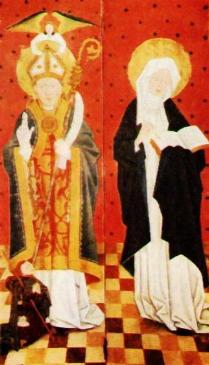
ST BIRGITTA OF SWEDEN:
HER RELICS

Bishop Hemming of Turku, Finland, St Birgitta of Sweden, Urdialu, Finland

Birgitta of Sweden, Revelationes , Autograph Manuscript on Sienese Paper, Royal Library, Stockholm, Sweden
 t Birgitta of Sweden is especially celebrated this Jubilee of the Third Millennium of
Christendom for her indefatigable work for Christendom, her
vast book and her pilgrimages across the length and breadth of
Europe and beyond, even to Jerusalem itself. Her remains have
been carefully treasured for these six centuries. Though she
was of noble birth, these remains are such simple things as a
patched cloak made from an old dress, in which she used
herself to beg amongst other beggars outside the Clarissan St
Lawrence in Panisperna in Rome, while mending and patching her
colleagues' scant garb, and a pilgrim's bowl of wood.
t Birgitta of Sweden is especially celebrated this Jubilee of the Third Millennium of
Christendom for her indefatigable work for Christendom, her
vast book and her pilgrimages across the length and breadth of
Europe and beyond, even to Jerusalem itself. Her remains have
been carefully treasured for these six centuries. Though she
was of noble birth, these remains are such simple things as a
patched cloak made from an old dress, in which she used
herself to beg amongst other beggars outside the Clarissan St
Lawrence in Panisperna in Rome, while mending and patching her
colleagues' scant garb, and a pilgrim's bowl of wood.
This essay reviews two important books on St Birgitta's relics: Aron Andersson and Anne Marie Franzén, Birgittareliker (Swedish and English) (Stockholm: Alqvist & Wiksells, 1975); Artur Bygdén, Nils Gustaf Gejvall, Carl Herman Hjortsjö, Les Reliques de Sainte Brigitte de Suède: Examen médico-anthrologique et historique (French); Heliga Birgittas Reliker (Swedish) (Lund: C.W.K. Gleerup, 1954).
The first relic discussed by Aron Andersson and Anne Marie Franzén is a delicately made cap which would have been worn by Birgitta under her white and black widow's veil. It is smocked and gathered from two pieces of linen cloth and tied under the chin, which would have been hidden beneath Birgitta's customary white wimple. We see a similar cap in the Via Veritatis fresco in the Dominican Spanish Chapel in Florence being worn by her daughter, St Catherine of Sweden. these were likely made by St Birgitta herself. The relic is treasured at Maria Refugie, Uden, Holland, coming there from the suppressed Brigittine Marienforst, near Bonn, founded in 1450.

In Birgitta's vision of Nicolo Acciauoli 's death and judgment, Revelationes IV.7.22-30, Mary appears in her humble cloak of mercy, beneath which the Dominican Friends of God and the Carthusians of Florence's Certosa, which he had built, gather and pray for his soul.

One can also see at San Lorenzo in Panisperna the grill to which the Clarissan Francesca de Sabellis crawled to be near the body of the saint that night, in the morning finding herself cured. I give here the text concerning that miracle from the document written by the Brigittine Johannes Johannis Kalmarnensis, formerly preserved at the Brigittine Paradiso in Florence and now in the Florentine State Archives.
At the Church of Santa Brigida in Rome are kept her
hair shirt and the board of walnut, the size of a refectory
table, on which she ate, wrote, and on which, it is said in
the manuscript given to Thomas
Gascoigne, she was laid at her death. Fragments of this
board are kept in reliquaries in many places.

Margery Kempe tells us she stood in this room in Rome, by the English College, for she kneeled there on the stone on which Christ stood in the vision to Birgitta announcing her death, and she would have seen this tawny board.
._ _
_ 
Birgitta's vision as a child of
Christ bleeding, announcing she is his Bride, a vision to a
disciple who sees her with
seven tiaras, the dictation to her of the Revelationes
by Jesus and
Maryand finally Christ's
appearance to her in her oratory telling her of her coming
death.
Perhaps Julian also did. For she describes it in the Showing of Love.
The fifth relic discussed is St Birgitta's pilgrim bowl of birch or maple preserved at the Brigittine Priory in Altomunster. I have held it in my hands and it is exactly the dimension of one's hands cupped for holding water. It has an inscription in Cyrillic: ' estj iesus nazarenus rex iudeorum', the inscription on the cross given in John 19.19, preceded by ' estj' 'it is, this is'. On its bottom a date is given, letters being also numbers in Old Church Slavonic as in Hebrew, of 'SXYS', which translates as being of A.D. 1188 (6696-5508=1188).
This simple wooden bowl would have come to St Birgitta from a Slavic region both under Catholic and Orthodox influences since it gives a Latin text in Cyrillic letters. Perhaps it is a gift from Bishop Hemming of Turku or from Birgitta's brother, Israel, both of whom had dealings with Slavic Baltic areas. It was likely not a drinking bowl, though a late Italian inscription on it says ' Ciotola doue beueua S: Brigida', but instead a Slavic Eucharist paten, Catholicism prohibiting these being made from wood, which Orthodoxy permitted. It likely journeyed with Birgitta from the Baltic regions to Jerusalem and back, surviving shipwreck.

Also preserved at Altomunster is St Birgitta's pilgrim staff of juniper wood, again which I have held in my hand, the two items passed to me by the Brigittine Prioress through the convent's grill.
Once preserved at Vadstena, but now, since the Reformation in Sweden, kept at the University Library at Uppsala is the book perhaps written by Thomas de Froidmont for his sister Margaret of Jerusalem, here attributed to St Bernard writing to his sister. The manuscript is from Spain, perhaps acquired by Birgitta on pilgrimage to Compostela there, perhaps given to her in Rome by the Spanish Bishop Hermit, Alfonso of Jaén . It is bound in leather with a flap with an embroidered knop for a button such as we also see on the coif and mantle, and indeed on other Brigittine nuns' books. The manuscript's cover has written on it: ' Hunc librum qui intytulatur doctrina Bernardi ad sororem portavit Beata mater nostra sancta Birgitta continuo in sinu suo ideo inter reliquies suas asseruandus est'. Interestingly, if she were its original recipient, Margaret of Jerusalem , carried out the great pilgrimages Birgitta also did, to Compostela, Rome, Jerusalem. A later rendition of it into Middle English will immediately precede Julian of Norwich's Showing of Love in the Amherst Manuscript, there being called the Golden Epistle.

Uppsala University Library, C240, open to '{ Soror mea'
The second scholarly study of Birgitta's relics is of interest for showing both the sense of awe in which the bones of saints were held and the uses to which they could be put. When medical and anthropological scholars examined the contents of St Birgitta's Shrine in Vadstena they did not find a complete skeleton, but instead a conglomeration of bones, from different women and men, one labeled ' de sto sigfrido'.
Outside of that Vadstena Shrine relics were and are preserved in reliquaries. I have seen the arm reliquary kept in the Chapter Room at Altomunster Priory. Chancellor of Oxford, Thomas Gascoigne, (whose descendant, Margaret Gascoigne , was to copy out part of Julian of Norwich's Showing of Love), gave a relic of St Birgitta to Oseney Abbey at Oxford, noting that fact in a pastedown in the Syon Abbey Martilogy, a manuscript that then went to Lisbon and returned to England, being now in the British Library.
Let us turn back to our image of St Birgitta and the autograph scrap of her writing:

Bishop Hemming of Turku, Finland, St Birgitta of Sweden, Urdialu, Finland

Birgitta of Sweden, Revelationes , Autograph Manuscript, Royal Library, Stockholm, Sweden
This is Birgitta's iconography, of the saint poised, pen in hand, in the act of writing down her vision in her handwriting. In this Finnish diptych Birgitta is shown garbed in white with a black cloak, like a Dominican mantellata. Her other advisor when she was still in Sweden was Magister Mathias who studied in Paris with the Dominicans and was buried with them in Stockholm. It is just possible that Magister Matthias introduced Birgitta into the underground spiritual movement amongst the Dominicans, begun by Meister Eckhardt, influenced by his study of Marguerite Porete , and which spread throughout Europe amongst men and women Dominicans, and which was called the 'Friends of God '. The Paris Doctors of Theology, of all the Orders, Benedictine, Cistercian, Victorine, Augustinian, Carmelite, Franciscan, Dominican, had condemned Marguerite Porete to burning at the stake in 1310 for her book, The Mirror of Simple Souls. Birgitta and her daughter Catherine are presented in the scene in Dominican Santa Maria Novella and are associated with Dominican Catherine of Siena . Birgitta clearly uses the phrase 'Friends of God' and does so continuously in her Revelationes. Her great admirer, Chiara Gambacorta will become a Dominican Prioress who fills her convent with images of Birgitta writing and as Dominican.
Birgitta belonged, however, to all the great religious Orders of Europe. She began her ministry at Cistercian Alvastra and wrote her Rule modeled upon the Cistercian Rule. She borrowed as well from that of St Clare of the Franciscan Order. Her final editor, the Bishop Hermit Alfonso of Jaen , was associated with a now extinct Order, his brother Peter founding the Hieronymite Order of Hermits, of which a famous member would be the brilliant Sor Juana de la Cruz in Mexico City. Birgitta's greatest supporter would be the Benedictine Cardinal Adam Easton of Norwich, though during her lifetime Birgitta had been critical of Benedictine corruption, wealth and worldliness. Then, at the Reformation in Sweden, when State turned against Church. statues of Birgitta writing her Revelationes had her writing hand struck off, her books called in. Kings feared that prophetic hand's text. Her silver arm reliquaries, once treasured so greatly, tend to show her fingers delicately holding a lost quill. These relics can make her text, despite six centuries, tangible, present, human.
Thus in our study of texts we need, not only to study their contexts, and, in the case of a saint, the documents of their canonization, Birgitta's including the oral testimony of Flemish servant girls, Roman nuns, Swedish mothers and many more witnesses, but even the very garments, even the very bones, of their writers, to find these are interlaced through time and space, that such textual communities preserved scraps of parchment, of paper, of cloth, of wood, and of bone, holding these dearworthy where - especially - a woman saint has spoken and written, in Quaker parlance, 'Truth to Power'. Birgitta of Sweden, Europe's Co-Patroness, is present in these fragments, in our midst, everywhere, her patched cloak enveloping us all.

Detail, ' Birgitta's
Vision at Bethlehem '. Chiara
Gambacorta , whose father was with Birgitta in Jerusalem
and Bethlehem, and who was a friend of both Alfonso of Jaen
and Catherine of Siena, comissioned this portrait painting by
Turino Vanni for her convent in Pisa, San Domenico. Now, Pisa,
Museo Nazionale di San Matteo.
If only we had a similar tangible reality across six
centuries, apart from our surviving texts, concerning Julian
of Norwich and her friend Margery of Lynn. Our earliest
manuscript of Julian of Norwich's Showing of Love
contains Cistercian Thomas de
Froidmont writing to his sister Margaret of Jerusalem; Marguerite Porete
's Mirror of Simple Souls; a fragment of the Horologium
Sapientiae by the Dominican Friend of God Henry Suso who wrote for and about
Elsbeth Stagel; a fragment from Birgitta of Sweden's Revelationes;
Jan van Ruusbroec's Sparkling
Stone, he a friend of the Friends of God; the English
hermit Richard Rolle's writings for anchoresses, especially
Margaret Kirkeby; and the English Carmelite Richard Misyn's
translations of Richard Rolle for the anchoress Margaret
Heslyngton; the manuscript then coming into Carthusian and
Brigittine ownership. While Margery, also, was exposed to such
a library of contemplative texts by Dominicans and Carmelites,
her manuscript likewise being preserved by Carthusians. All of
these women sought to gather the divisions of the Church under
Mary's patchworked cloak, sewing together its pathetic tatters
again into the love of God's Wisdom.
Indices
to Umiltà Website's Essays on Julian:
Preface
Influences
on Julian
Her Self
Her
Contemporaries
Her
Manuscript Texts ♫ with recorded readings of them
About Her
Manuscript Texts
After
Julian, Her Editors
Julian in
our Day
Publications related to Julian:
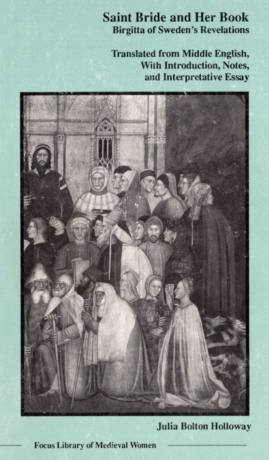

Saint Bride and Her Book: Birgitta of Sweden's Revelations Translated from Latin and Middle English with Introduction, Notes and Interpretative Essay. Focus Library of Medieval Women. Series Editor, Jane Chance. xv + 164 pp. Revised, republished, Boydell and Brewer, 1997. Republished, Boydell and Brewer, 2000. ISBN 0-941051-18-8
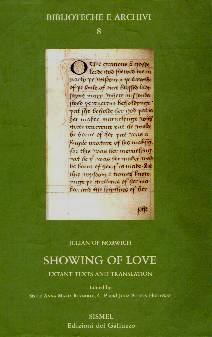 To see an example of a
page inside with parallel text in Middle English and Modern
English, variants and explanatory notes, click here. Index to this book at http://www.umilta.net/julsismelindex.html
To see an example of a
page inside with parallel text in Middle English and Modern
English, variants and explanatory notes, click here. Index to this book at http://www.umilta.net/julsismelindex.html
Julian of
Norwich. Showing of Love: Extant Texts and Translation. Edited.
Sister Anna Maria Reynolds, C.P. and Julia Bolton Holloway.
Florence: SISMEL Edizioni del Galluzzo (Click
on British flag, enter 'Julian of Norwich' in search
box), 2001. Biblioteche e Archivi
8. XIV + 848 pp. ISBN 88-8450-095-8.
 To see inside this book, where God's words are
in red, Julian's in black, her
editor's in grey, click here.
To see inside this book, where God's words are
in red, Julian's in black, her
editor's in grey, click here.
Julian of
Norwich. Showing of Love. Translated, Julia Bolton
Holloway. Collegeville:
Liturgical Press;
London; Darton, Longman and Todd, 2003. Amazon
ISBN 0-8146-5169-0/ ISBN 023252503X. xxxiv + 133 pp. Index.
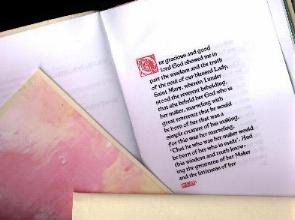 To view sample copies, actual
size, click here.
To view sample copies, actual
size, click here.

'Colections'
by an English Nun in Exile: Bibliothèque Mazarine 1202.
Ed. Julia Bolton Holloway, Hermit of the Holy Family. Analecta
Cartusiana 119:26. Eds. James Hogg, Alain Girard, Daniel Le
Blévec. Salzburg: Institut für Anglistik und Amerikanistik
Universität Salzburg, 2006.
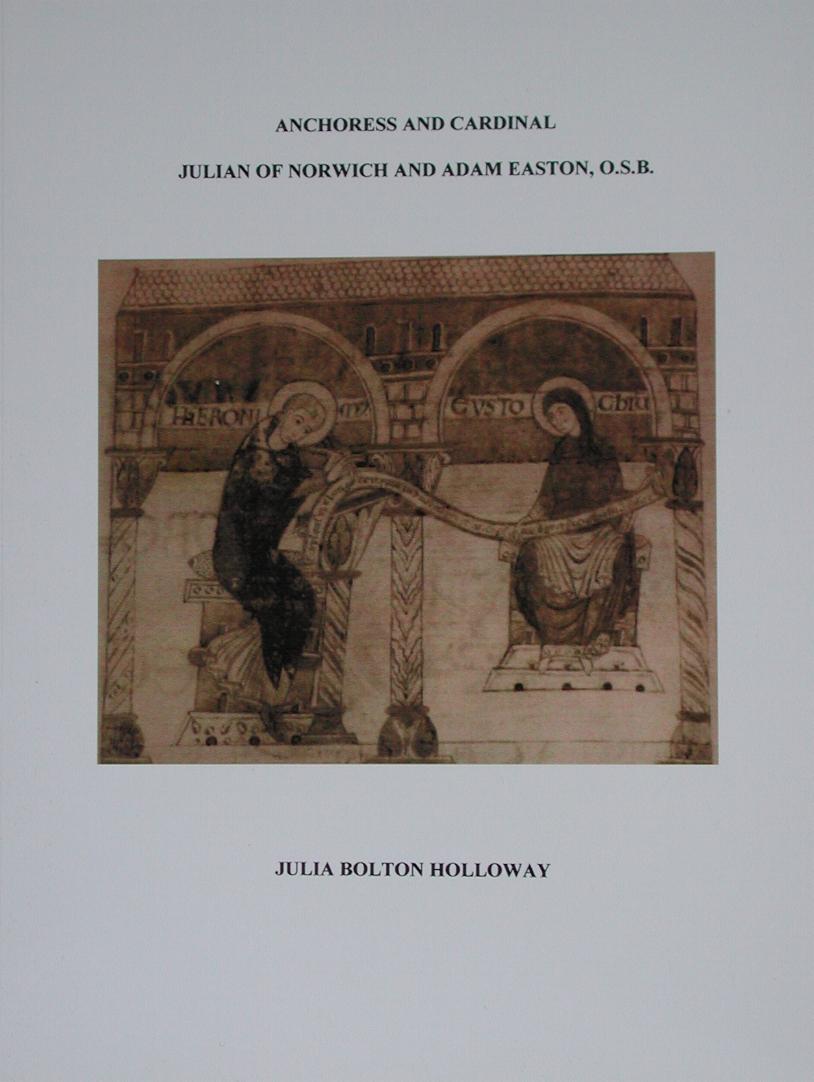
Anchoress and Cardinal: Julian of
Norwich and Adam Easton OSB. Analecta Cartusiana 35:20 Spiritualität
Heute und Gestern. Salzburg: Institut für Anglistik und
Amerikanistik Universität Salzburg, 2008. ISBN
978-3-902649-01-0. ix + 399 pp. Index. Plates.
Teresa Morris. Julian of Norwich: A
Comprehensive Bibliography and Handbook. Preface,
Julia Bolton Holloway. Lewiston: Edwin Mellen Press, 2010.
x + 310 pp. ISBN-13: 978-0-7734-3678-7; ISBN-10:
0-7734-3678-2. Maps. Index.

Fr Brendan
Pelphrey. Lo, How I Love Thee: Divine Love in Julian
of Norwich. Ed. Julia Bolton Holloway. Amazon,
2013. ISBN 978-1470198299

Julian among
the Books: Julian of Norwich's Theological Library.
Newcastle upon Tyne: Cambridge
Scholars Publishing, 2016. xxi + 328 pp. VII Plates, 59
Figures. ISBN (10): 1-4438-8894-X, ISBN (13)
978-1-4438-8894-3.

Mary's Dowry; An Anthology of
Pilgrim and Contemplative Writings/ La Dote di
Maria:Antologie di
Testi di Pellegrine e Contemplativi.
Traduzione di Gabriella Del Lungo
Camiciotto. Testo a fronte, inglese/italiano. Analecta
Cartusiana 35:21 Spiritualität Heute und Gestern.
Salzburg: Institut für Anglistik und Amerikanistik
Universität Salzburg, 2017. ISBN 978-3-903185-07-4. ix
+ 484 pp.
| To donate to the restoration by Roma of Florence's
formerly abandoned English Cemetery and to its Library
click on our Aureo Anello Associazione:'s
PayPal button: THANKYOU! |
JULIAN OF NORWICH, HER SHOWING OF LOVE AND ITS CONTEXTS ©1997-2024 JULIA BOLTON HOLLOWAY || JULIAN OF NORWICH || SHOWING OF LOVE || HER TEXTS || HER SELF || ABOUT HER TEXTS || BEFORE JULIAN || HER CONTEMPORARIES || AFTER JULIAN || JULIAN IN OUR TIME || ST BIRGITTA OF SWEDEN || BIBLE AND WOMEN || EQUALLY IN GOD'S IMAGE || MIRROR OF SAINTS || BENEDICTINISM || THE CLOISTER || ITS SCRIPTORIUM || AMHERST MANUSCRIPT || PRAYER || CATALOGUE AND PORTFOLIO (HANDCRAFTS, BOOKS ) || BOOK REVIEWS || BIBLIOGRAPHY ||
